This guide will help you learn propagation, repotting and care of Pink Princess Philodendron in very easy and simple ways.
The best part?
This guide is equally useful for beginners, intermediate and advanced houseplant enthusiasts. You’ll find here a detailed comparison of closely related plants to Pink Princess. (In other words: you don’t need to worry about reading thin stuff.)
So without further ado, let’s get started…
Pink Princess Philodendron (Fun Facts)
| Scientific Name | Philodendron erubescens |
| Common Names | Philodendron pink Princess, blushing Philodendron |
| Family | Araceae |
| Plant Type | Perennial |
| Mature Size | Tall 4-5 ft./90-120 cm, Wide 2-4 ft./30-60 cm |
| Sun Exposure | Bright Indirect Sunlight for 6 to 8 Hours |
| Soil Type | Loamy, Well-draining, Acidic soil |
| Bloom Time | Spring, summer |
| Flower Color | Green, white |
| Native Area | South America |
| Water | Once a week |
Pink Princess’s philodendron is on the wishlist of many gardeners. This plant is famous for its beautiful bubblegum color pink variegation.
This plant can enhance the aesthetic of any home interior. The pink princesses is slow-growing and perfect to fill any space in time. Philodendron pink princesses can produce flowers.
The flowers consist of white spadix and red-purple spathe. The indoor flowering of the pink philodendron plant is very rare. You need to have the perfect mimic of nature for that.
The philodendrons can also produce fruit-like berry shapes. Flowering and fruiting are most likely to happen in the wild.
This plant is toxic to humans and pets if ingested. Pink Princess is not focused on flowers or fruit. People like the pink princesses for their variegation. The leaves of this species are heart-shaped. The color of the leaves is dark green, with pink variegation.
Essential Care Tips for Beginners
Placement
Place your plant in bright indirect sunlight. Direct sunlight will scorch the leaves.
Watering
Water your plant when the top 1 to 2 inches of soil is dry. Avoid overwatering; it can lead to root rot.
Soil Selection
The soil must be well-drained and moist. Add perlite, orchid bark, and peat moss for well-drain soil.
Benefits

Here is the list of benefits for growing pink princess philodendron:
Aesthetic Appeal
The leaves of this flora provide a striking appearance. This plant is the perfect addition to your home’s aesthetic.
Air Purification
This plant works as an air purifier. Absorb harmful chemicals and make your surroundings clean.
Mood Enhancement
Pink princess philodendrons enhance your mood and reduce stress and anxiety. The pink princesses also boost your productivity.
Low Maintenance
This plant is low maintenance. The perfect option for experienced and novice gardeners.
Improves Humidity
Pink philodendron releases the water during the process of transpiring. This increases the humidity around you, which is beneficial in dry environments.
Promotes Wellbeing
By taking care of the philodendron, it provides a feeling of satisfaction. Watching your plant grow can improve your well-being.
Continuous Learning and Engagement
Keeping the pink princess philodendron is not just about care. You learn new experiences about plants’ needs and behavior.
Propagation
Step 1: Prepare Your Cutting
- Tools: Shears and Scissors.
- Supplies: A healthy Stem
Make sure the equipment is sterili. You need to select a healthy stem with no discoloration. The stem should have at least 4 to 5 leaves. Remove the leaves from the bottom, exposing nodes.
Step 2: Allow Cut to Callous
- Supplies: A Dry, Safe Place
Leave the cutting to dry for 12 to 24 hours to cover edges with callous.
Step 3: Start the Water Propagation
- Tools: Jar or Glass
- Supplies: Water
When the edges are covered with the callous. Place the cutting into the jar of water. Make sure exposed nodes are completely submerged in the water.
Step 4: Root Development
Place the cutting into the warm and humid area. Do not place it in direct sunlight. In some weeks, the new roots will sprout.
Step 5: Planting in Soil
- Tools: Pot
- Supplies: Well-Draining Potting Mix and Water
To plant cutting, you need a pot with a drainage hole and well-drained soil. When roots are 1 inch long place your cutting into the plant. Hold it in a position and add soil. Water the pot to ensure the drainage hole is working fine.
Patience and Observational Care
This plant needs perfect temperature and humidity levels to grow. Keep the flora in bright indirect light. Monitor your plant daily to check if the roots are growing fine.
Repotting
This plant needs repotting every 1 to 2 years. The signs of repotting can be the outgrowth of roots from the drainage hole of the pot. The best time to repot the pink philodendron is when it’s active during the growth period. The summer and spring season is best. It will provide this species with an edge to adjust to a new environment. Here is the complete guide on how to repot your plant:
- Take a new pot 3 to 4 inches bigger than the previous one
- Ensure that the new pot has drainage holes
- A ceramic or terracotta pot is recommended
- Make sure to have a potting mix
- Remove the pink princess from the old pot
- Loosen the roots to dust off old soil
- Place the pink philodendron into the pot
- Hold the plant in the position and add the soil
- Water the pot to settle the soil and to see if the drainage hole is working
- Place the pot back to its old location and resume the watering schedule
Care
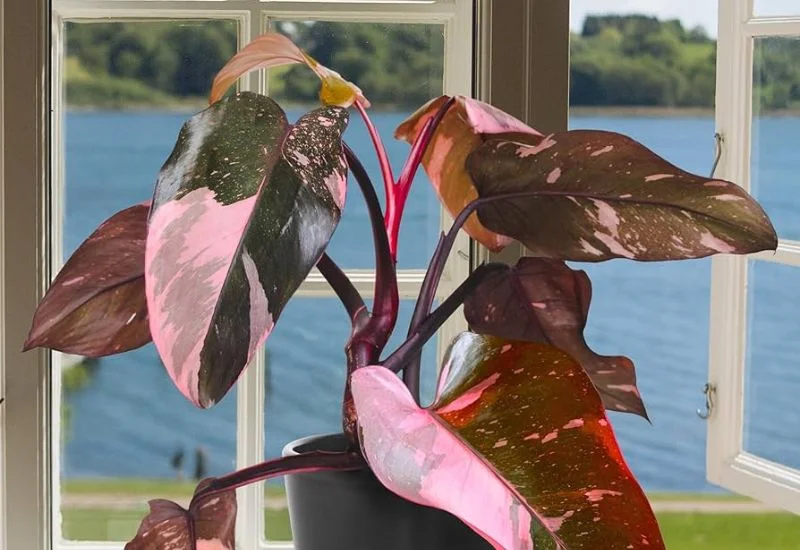
Here is the following care guide for your pink princess philodendron:
Step 1: Pot Selection
- A ceramic or terracotta-made pot is recommended. These pots can hold needed moisture. The material can absorb extra moisture from the soil. These pots provide breathing space to the roots.
Step 2: Soil Requirements
- This plant needs well-drained and moist soil. The soil should have the capacity to hold onto enough moisture for the pink princesses. You can make your soil clean from chemicals. Take an equal amount of perlite, peat moss, and orchid bark. Add organic matter to provide extra nutrients.
Step 3: Placement
- Place the philodendron pink near the window, where bright indirect light is available. If you do not have a perfect spot, you can also place plant light to complete light requirements. On the location, the temperature and humidity must be as per the needs of the plant. Make sure to provide needed air circulation.
Step 4: Lighting Conditions
- Pink Princess Philodendron requires bright indirect light. The variegation of the plant depends on the quality of light. If you have placed the flora indoors, it can survive a few hours of direct sunlight. An inadequate amount of light can make the leaves of plants revert to green. More exposure to sunlight can scrooch the leaves.
Step 5: Watering
- In summer, a spring plant needs water once a week. In winter and fall, the plant needs water once every two weeks. Let the top inch of soil dry before watering. If you are not sure when to water your plant. You can use a moisture meter to check the soil.
Step 6: Temperature and Humidity
- This plant prefers a little warm and humid area. This variety can thrive at average household temperature and humidity levels. The preferred temperature for the pink princesses is 65 °F to 70 °F.
- If the environment of your home is too dry you can increase the humidity around your plant. Place a humidifier or tray filled with pebbles and water.
Step 7: Fertilization
- The philodendron pink princess needs a liquid-based fertilizer. Apply fertilizer in spring and summer, and stop when the temperature starts to fall.
Step 8: Pruning
- The pink princess is very low maintenance. Pink Princess does not need frequent pruning. You can prune the philodendron to maintain its growth and size. Use only sterilized pruning shears. The best time to prune your plant is spring and summer.
Step 9: Seasons
- Winter
In winter your plants need water once every two weeks. Stop using fertilizers in winter and fall.
- Summer
In summer the species needs water once every week. Apply the fertilizer after watering your plant once a month.
Regular Review and Adjustment
To maintain the care of regularly check the light, soil, and watering needs. If there is any issue in any of these factors adjust them as per the need of the pink philodendron.
Common Problems

Pests
Spider mites, mealybugs, scale insects, and fungus gnats are the most common pests. These pests start consuming your plant. To prevent their damage, check your plant daily. If found, wipe them off with a damp cloth. You can also use a solution spray.
Fungal Diseases
Diagnosis
Unpleasant smell from the roots, black spots on the leaves.
Causes
- Overwatering
- poor drainage
- bacterial fungus infection
Solution
- Avoid overwatering
- Check the drainage holes of the pot
- Place your plant in bright, indirect sunlight
Brown Tips
Diagnosis
Leaves turning brown
Causes
- Overuse of fertilizer
- Overwatering
- Underwatering
- More exposure to the sun
Solution
- Wash soil with fresh water to reduce salt build-up caused by fertilizer
- Avoid overwatering
- Place your plant in bright but indirect sunlight
Curling Leaves
Diagnosis
Leaves start to curl from the edges.
Causes
- More exposure to the sun
- Overwatering
- Environment stress
- Pest infection
Solution
- Avoid overwatering
- Place your plant in a location where bright indirect sunlight is available
- Inspect your plant for pest infection
Yellow leaves
Diagnosis
Young leaves, or more leaves, start to turn yellow.
Causes
- Overwatering
- Underwatering
- More exposure to the sun
- Less exposure to the sun
- Nutrients deficiency
Solution
- Avoid overwatering and underwatering
- Place the flora in a location where the needed bright indirect sunlight is available
- Add fertilizer to fulfil the need for nutrients
Proactive Health Monitoring
Maintain your pink princess philodendron by monitoring your plant. Inspect your plant daily for any pest infection. Check soil quality to assess watering habits. Maintain the required temperature and humidity level.
Varieties & Similar Plants
Here is the list of varieties and similar plants of pink princesses philodendron:
Varieties
- Philodendron ‘Blushing Bride’
- Philodendron ‘Pink Congo’
Similar plants
- Philodendron ‘White Wizard’
- Philodendron ‘White Knight’
Pink Princess Philodendron Vs. Other Philodendrons
Here is a detailed comparison between P. Princess Philodendron and other Philodendrons that mostly resemble it but have minor key differences.
Blushing Philodendron Vs. Pink Princess
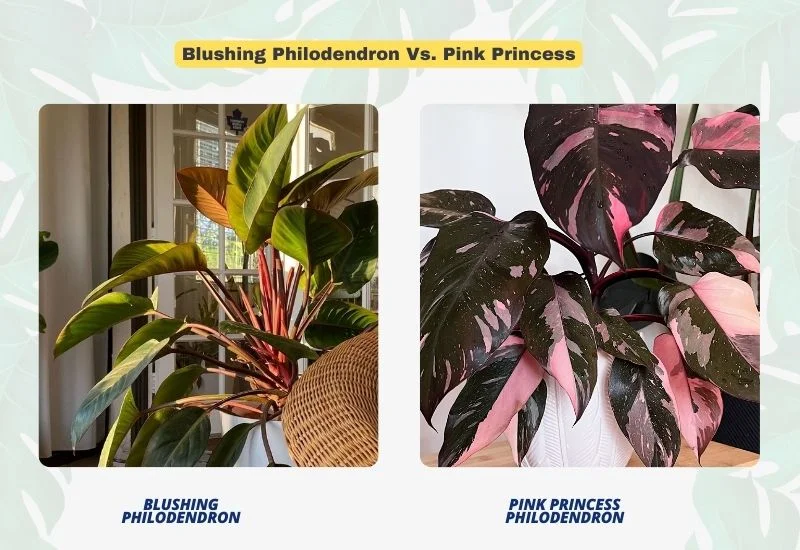
The following are the differences and similarities between Blushing Philodendron and P. Pink Princess, which have easy-to-understand tables.
Differences
There are 10 key differences.
| Differences | Pink Princess | Blushing philodendron |
| Leaves | The leaves are more oval with rounded ends and are in a deep green to purple shade with pink variegation. | Glossy heart-shaped leaves with coloration of deep green-purple or dark red |
| Flowers | White spadix with purple-red spathe | Fragrant flowers with deep red spathe |
| Stems | The stem’s color is more burgundy. | Vibrant red stems |
| Growth pattern | This plant reaches 74 cm long and 73 cm wide. | The length can get up to 3 feet tall and 16 inches wide. |
| Temperature | 65 °F to 80 °F | 65 °F to 85 °F |
| Price | $95 to $135 | $18 to $25 |
| Availability | Moderate | Common |
| Growth rate | Moderate to fast | Fast growing |
| Hardiness zone | 9-11 | 10-12 |
| Native area | South America | Colombia |
Similarities
There are 9 similarities between both plants.
| Similarities | Pink Princess | Blushing philodendron |
| Watering needs | This plant needs water for 7 to 10 days depending on the environment. | Water the philodendron in 7 to 10 days |
| Soil | Needs moist soil and well-drained soil to thrive | Moist and well-drained soil |
| Placement | Place in bright indirect sunlight | Needs bright but indirect sunlight |
| Fruit | Fruits are not edible and have a berry-like shape. | Berry-like fruit, which is not edible |
| Roots | The roost spread wide instead of going deep. | Horizontal growth instead of deep rooting |
| Toxicity | Toxic to humans and pets | Toxic to humans and pets |
| Disease attack | Moderate | Moderate |
| Fertilizer | Once a week | Once a week |
| Bloom time | Spring, summer | Spring, Summer |
Philodendron Pink Princess Marble Vs. Pink Princess
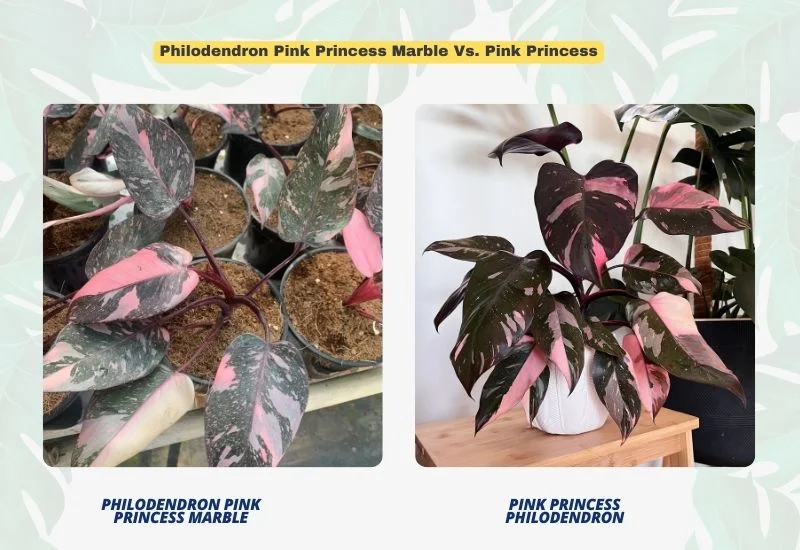
The following are the differences and similarities between P. Pink Princess Marble and P. Pink Princess, which have easy-to-understand tables.
Differences
There are 7 key differences.
| Differences | Pink Princess | Pink princess marble philodendron |
| Leaves | The leaves are more oval-shaped with rounded ends and have a deep green to purple shade with pink variegation. | Large heart shape glossy leaves with green and pink marble variegation |
| Flowers | White spadix with purple-red spathe | Creamy white spathe with white or yellow spadix |
| Stems | The stem’s color is more burgundy. | Dark green or burgundy color |
| Growth pattern | This plant reaches 74 cm long and 73 cm wide. | The length can reach up to 3 to 4 feet and is 0.25 in diameter |
| Temperature | 65 °F to 80 °F | 65 °F to 79 °F |
| Price | $95 to $135 | $40 to $50 |
| Availability | Moderate | Rare |
Similarities
There are 12 similarities between both plants.
| Similarities | Pink Princess | P. Princess marble philodendron |
| Watering needs | Plants need watering in 7 to 10 days. | This species needs water in 7 to 10 days. |
| Soil | Needs moist soil and well-drained soil to thrive. | Need moist and well-drained soil. |
| Placement | Place in bright indirect sunlight | Need bright but indirect sunlight |
| Fruit | Fruit is not edible and has a berry-like shape. | Fruit is like a small berry which is non-edible. |
| Roots | The roost spread wide instead of going deep. | Wide-spread roots instead of going deep |
| Toxicity | Toxic to humans and pets | Toxic to humans and pets |
| Habitat | South America | South America |
| Disease attack | Moderate | Moderate |
| Fertilizer | Once a week | Once a week |
| Bloom time | Spring, summer | Spring, Summer |
| Growth rate | Moderate to fast | Moderate to fast |
| Hardiness zone | 9-11 | 9-11 |
Imperial Red Philodendron Vs. Pink Princess

The following are the differences and similarities between Imperial Red Philodendron and P. Pink Princess, which have easy-to-understand tables.
Differences
There are 9 key differences.
| Differences | Pink Princess | Imperial red philodendron |
| Leaves | The leaves are more oval-shaped with rounded ends and have a deep green to purple shade with pink variegation. | Large heart-shaped leaves with glossy sheen. |
| Flowers | White spadix with purple-red spathe | Creamy white or pale green spathe with white or pale yellow spadix. |
| Stems | The stem’s color is more burgundy. | Red stems |
| Growth pattern | This plant reaches 74 cm long and 73 cm wide. | The philodendron red imperial can grow up to 2 to 3 feet in height and the same in width. |
| Temperature | 65 °F to 80 °F | 65 °F to 85 °F |
| Price | $95 to $135 | $25 to $40 |
| Availability | Moderate | Common |
| Growth rate | Moderate to fast | Moderate growth |
| Hardiness zone | 9-11 | 10-11 |
Similarities
There are 10 similarities between both plants.
| Similarities | Pink Princess | Imperial red philodendron |
| Watering needs | Plants need water in 7 to 10 days. | The flora acquires water in 7 to 10 days. |
| Soil | Needs moist and well-drained soil to thrive. | Need moist and well-drained soil |
| Placement | Place in bright indirect sunlight | Needs bright, indirect sunlight |
| Fruit | Fruits are not edible and have a berry-like shape. | Small berries like non-edible fruit. |
| Roots | The roost spread wide instead of going deep. | Spread widely and cover the maximum area |
| Toxicity | Toxic to humans and pets | Toxic to humans and pets |
| Habitat | South America | South America |
| Disease attack | Moderate | Moderate |
| Fertilizer | Once a week | Once a week |
| Bloom time | Spring, summer | Spring, summer |
Philodendron Red Anderson Vs. Pink Princess
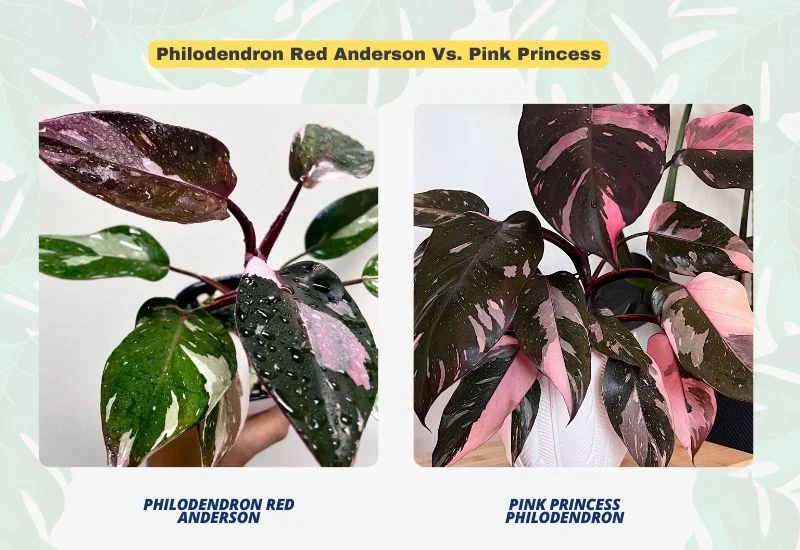
The following are the differences and similarities between Philodendron Red Anderson and P. Pink Princess, which have easy-to-understand tables.
Differences
There are 10 key differences.
| Differences | Pink Princess | Philodendron red anderson |
| Leaves | The leaves are more oval-shaped with rounded ends and have a deep green to purple shade with pink variegation. | The leaves are heart and arrow-shaped and have red and burgundy colors when young. As they mature, the color becomes more dark green with reddish |
| Flowers | White spadix with purple-red spathe | Spathe is creamy white and pale green in color with half-white spadix. |
| Stems | The stem’s color is more burgundy. | Greenish-burgundy when mature |
| Growth pattern | This plant reaches 74 cm long and 73 cm wide. | The leaves are heart and arrow-shaped and have red and burgundy colors when young. As they mature, the color becomes darker green with reddish |
| Temperature | 65 °F to 80 °F | 60 °F to 80 °F |
| Price | $95 to $135 | $25 to $50 |
| Availability | Moderate | Somewhat rare |
| Growth rate | Moderate to fast | Slow to moderate |
| Hardiness zone | 9-11 | 10 |
| Habitat | South America | Central South America and the Caribbean |
Similarities
There are 9 similarities between both plants.
| Similarities | Pink Princess | Philodendron red anderson |
| Watering needs | Every 7 to 10 days. | The red anderson needs water every 7 to 10 days. |
| Soil | Needs moist and well-drained soil to thrive | Need moist and well-drained soil |
| Placement | Place in bright indirect sunlight | Need bright indirect sunlight |
| Fruit | Fruits are not edible and have a berry-like shape. | Small berry-like fruit which is non-edible |
| Roots | The roost spread wide instead of going deep. | The roots spread wide, which is good for absorbing nutrients and moisture. |
| Toxicity | Toxic to humans and pets | Toxic to humans and pets |
| Disease attack | Moderate | Moderate |
| Fertilizer | Once a week | Once a week |
| Bloom time | Spring, summer | Spring, Summer |
Philodendron Black Cherry Vs. Pink Princess

The following are the differences and similarities between Philodendron Black Cherry and P. Pink Princess, which have easy-to-understand tables.
Differences
There are 10 key differences.
| Differences | Pink Princess | Black cherry philodendron |
| Leaves | The leaves are more oval-shaped with rounded ends and have a deep green to purple shade with pink variegation. | Large, broad leaves with heart shape. When young, the leaves are the color of vibrant cherry red. As the plant matures, its color changes to a darker burgundy or black shade. |
| Flowers | White spadix with purple-red spathe | Spathe is creamy white in color with white or pale yellow color spadix. |
| Stems | The stem’s color is more burgundy. | Deep burgundy to dark red |
| Growth pattern | This plant reaches 74 cm long and 73 cm wide. | the philodendron black can grow 5 to 8 feet long and 8 to 10 inches wide. |
| Temperature | 65 °F to 80 °F | 70 °F to 80 °F |
| Price | $95 to $135 | $25 to $60 |
| Availability | Moderate | Relatively rare |
| Growth rate | Moderate to fast | Slow |
| Hardiness zone | 9-11 | 10-12 |
| Habitat | South America | Central South America and the Caribbean |
Similarities
There are 10 similarities between both plants.
| Similarities | Pink Princess | Black cherry philodendron |
| Watering needs | Plants need watering every 7 to 10 days. | This species acquires water every 7 to 10 10 days. |
| Soil | Needs moist and well-drained soil to thrive | Need moist and well-drained soil |
| Placement | Place in bright indirect sunlight | Needs bright, indirect sunlight |
| Fruit | Fruits are not edible and have a berry-like shape. | Small berry-like fruit which is non-edible |
| Roots | The roost spread wide instead of going deep. | Roots spread wide instead of going deep. |
| Toxicity | Toxic to humans and pets | Toxic to humans and pets |
| Habitat | ||
| Disease attack | Moderate | Moderate |
| Fertilizer | Once a week | Once a week |
| Bloom time | Spring, summer | Spring, summer |
Philodendron Strawberry Shake Vs. Pink Princess
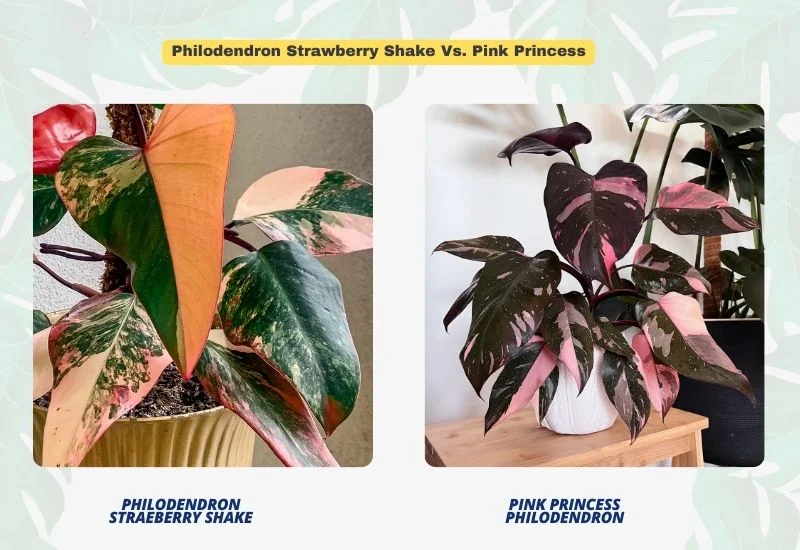
The following are the differences and similarities between Philodendron Strawberry Shake and P. Pink Princess, which have easy-to-understand tables.
Differences
There are 8 key differences.
| Differences | Pink Princess | Strawberry shake philodendron |
| Leaves | The leaves are more oval-shaped with rounded ends and have a deep green to purple shade with pink variegation. | The leaves are rectangular. As a juvenile, the plant leaves are red and turn green as it matures with creamy, yellow, white, red, or even orange variegation. |
| Flowers | White spadix with purple-red spathe | White, green flower |
| Stems | The stem’s color is more burgundy. | Pinkish to deep reddish color. |
| Growth pattern | This plant reaches 74 cm long and 73 cm wide. | A fully grown plant is 1 meter long and 30 cm wide. |
| Temperature | 65 °F to 80 °F | 55 °F to 80 °F |
| Price | $95 to $135 | $23 to $20 |
| Availability | Moderate | Rare |
| Growth rate | Moderate to fast | Moderate |
Similarities
There are 10 similarities between both plants.
| Similarities | Pink Princess | Strawberry shake philodendron |
| Watering needs | Plants need watering once a week | Needs watering once a week |
| Soil | It needs moist soil to thrive | It needs moist soil instead of soggy |
| Placement | Place in bright indirect sunlight | Place in bright indirect sunlight |
| fruit | Fruits are not edible and have a berry-like shape. | The fruits are not edible and are berry-like fruits. |
| Roots | The roost spread wide instead of going deep. | Roots spread wide horizontally instead of going deep. |
| Toxicity | Toxic to humans and pets | Toxic to humans and pets |
| Habitat | South America | South America |
| Disease attack | Moderate | Moderate |
| Fertilizer | Once a week | Once a week |
| Bloom time | Spring, summer | Spring, summer |
Buying Guide
Considerations Before Buying
Here are the following points to keep in consideration while buying pink princesses:
- The pink princess philodendron is rare so the cost will be a little high
- Before buying the philodendron pink, look for the spots on the leaves
- Examine the plant’s stems and foliage to check if it’s healthy
Price Range
This plant is expensive because it has a unique variegation. The price range will be from $95 to $135.
Where to Buy
Pink princess philodendron can be found on the Facebook marketplace and Etsy. This plant can be found in house plant shops and nurseries. Stores like Depot and Costa Forms also provide pink princesses.
I hope this guide helps you quickly learn to take care of Pink Princess Philodendron (and eventually master it).
Now I’d like to turn it over to you:
What was your favorite resource from this guide?
Or maybe you have an excellent piece of content that you think I should add.
Either way, let me know by leaving a comment below right now.
